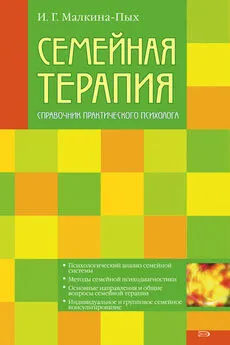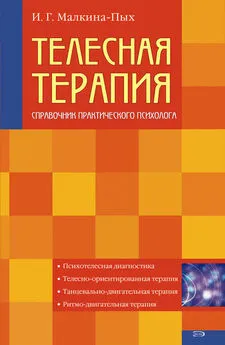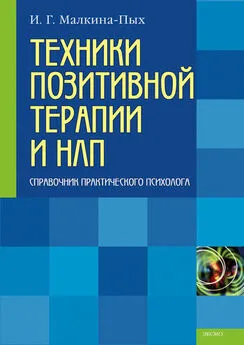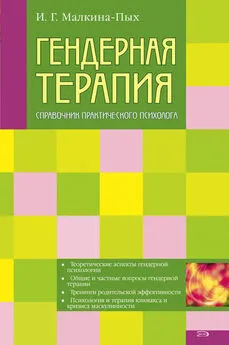Ирина Малкина-Пых - Семейная терапия
- Название:Семейная терапия
- Автор:
- Жанр:
- Издательство:неизвестно
- Год:неизвестен
- ISBN:нет данных
- Рейтинг:
- Избранное:Добавить в избранное
-
Отзывы:
-
Ваша оценка:
Ирина Малкина-Пых - Семейная терапия краткое содержание
Эта книга – руководство для психологов и консультантов, работающих в различных учреждениях (государственных и частных клиниках, школах, больницах и общественных центрах здоровья), желающих повысить эффективность своей работы с нуждающимися в психологической помощи клиентами.
Семейная терапия - читать онлайн бесплатно ознакомительный отрывок
Интервал:
Закладка:
3. Ощущение вины перед ребенком – довольно распространенный феномен, но эта вина особенно неадекватна в обсуждаемых случаях, поскольку относится к поступкам и событиям из давнего прошлого. Наиболее простая тактика работы в данном случае – продемонстрировать бессмысленность такого чувства вины. Сделать это можно по-разному, например, показав клиенту нецелесообразность, неуместность тех поступков, которые тот предпринимает с целью загладить свою вину. Такое поведение, часто принимающее форму вмешательства в чужую жизнь, лишь осложняет отношения с ребенком.
Список цитированной и рекомендуемой литературы
Abies В. S., Brandstna J. M. Therapy for couples. San Francisco, Jossey Bass, 1977.
Ackerman N. The Psychodynamics of family life. NEW YORK, Basic Books, 1958.
Ackerman N. The strenth of Family Therapy, Selected Papers/Eds. D. Bloch R. Simon Ackerman Institute of Family Therapy. NEW YORK, Brunner/Mazel, 1982.
Ackerman N. Treating of troubled family. NEW YORK, Basic Books, 1966.
Adams В. В. Mate selection in the Unated States. A theoretical summarization. // W. Butt, R. Hill, I. Nye, I. Reis (Eds.). Contemporary theories about the family (V. 1. P. 259–267). New York, Free Press. 1979.
Alger J. Multiple couple therapy // P. J. Guerin, Jr. (Ed.), Family therapy. Theory and practice. New York, Gardner Press, 1976.
Allport G. The open system in personality theory // Modern systems research for the behavioral scientist. W. Buckley (ed.). Chicago, Aldine, 1968.
Andolfi M. Family therapy, an interactional approach. New York – London, Plenum Press, 1980.
Andolfi M., Angelo C., Menghi P., Nicolo-Corigliano A. M. Behind the family mask, Therapeutic change in rigid family systems. New York, Guilford Press, 1983.
Andolfi M. Redefinition in family therapy // American Journal of Family Therapy, 1979. V. 7. P. 5 – 15.
Andolfi M. , Zwerling I. (eds.) Dimensions of family therapy. New York, Guilford Press, 1980.
Aponte H. J., Van Deusen J.M . Structural family therapy // A. Curman, Kniskern (eds). Handbook of family therapy. New York, Brunner-Mazel, 1981.
Ard B. N., Ard С. С. (eds.) Handbook of marriage counseling. Palo Alto, Calif., Science and Behavior Books, 1969.
Atteneave С. L . Therapy in tribal settings and urban network intervention // Family Process, 1969. P. 192–210.
Atteneave С . Social networks as the unit of intervention // P. J. Guerin (ed.), Family therapy theory and practice. New York, Gardner Press, 1976.
Bach O., Scholz M. (Hrsg). Familientherapie und Familien– forschung. Leipzig, Hirzel, 1980.
Bach G. R. The marathon group. Intensive practice of intimate interaction // Psychological Reports, 1966. V. 18. P. 995 – 1000.
Bane M. G . Marital distraction and the lives of children // Divorce and separation. G. Levinger, O. C. Moles (eds.). New York, Guilford Press, 1979.
Barcai A. Normative family development // Journal of marriage and the family therapy. 1981. V 7. № 3. P. 353–360.
Barker Ph. Basic Family Therapy. London, Granade, 1981.
Barnhill L. R., Lоngо D. Fixation and regression in the family life cycle // Family Process. 1978. V. 77. P. 469–478.
Barten H. H. (ed.) Brief Therapies. New York, Behavioral Publications, 1971.
Barton С ., Alexander J. F . Functional family therapy // Handbook of family therapy. A. S. Gurman, D. P. Kniskern (eds.). New York, Brunner/Mazel, 1981.
Bateson G., Jackson, D. D ., Haley J., Weakland J. H. Toward a theory of schizophrenia // Behavioral Science, 1956. V. 1. P. 34–56.
Bauer R . Gestalt therapy strategies to reduce projection in families // A. Gurman (ed.). Questions and answers in the practice of family therapy. New York, Brunner/Mazel, 1981.
Baumrind D . The contributions of the family to the development of competence in children // Schizophrenia Bulletin, 1975. V. 14. P. 12–37.
Beavers R. W. Successful marriage. New York, Norton. 1985.
Beavers W. R. Healthy, midrange, and severely dysfunctional families // F. Walsh (ed.). Normal family processes. New York, Guilford Press, 1982.
Beels C. C., Ferber A. Family therapy. A view // Family Process, 1969. V. 8. P. 280–332.
Bell J. E. Family group therapy (Public Health Monograph No. 64). D.C. Washington, U.S. Government Printing Office, 1961.
Bell N. W. Extended family relations of disturbed and well families // Family Process. 1962. V. 1. P. 175–193.
Bentovim A., Kinston W. Focal family therapy // Handbook of family therapy. V. II. A. S. Gurman, D.P. Kniskern (eds.). New York, Brunner/Mazel, 1991.
Berg I. K., De Jоng P. Solution-building conversations. Co– constructing a sense of competence with clients // Families in Society, The Journal of Contemporary Human Services. 1996, June, P. 376–391.
Berg I. K., de Shazer S. Making numbers talk, language in therapy. // The new language of change, S. Friedman (ed.). New York, Guilford Press, 1993.
Berg I., Miller S. Working with the problem drinker. A solution– focused approach. New York, Norton, 1992.
Berger H. G. Somatic pain and school avoidance // Clinical Pediatrics, 1974. P. 819–826.
Berkovitz I. H., Sugar M . Adolescent psychotherapy, group psychotherapy, family psychotherapy // M. Sugar (ed.), The adolescent in group and family therapy. New York, Brunner/Mazel, 1975.
Bertalanffy L. von. Treatment of families in conflict. New York, Jason Aronson, 1970.
Bertalanffy L. von. Changing families. A family therapy reader. New York, Grune and Stratton. 1971.
Blechman E. A. Family problem-solving training // American Journal of Family Therapy, 1980. V. 8 P. 3 – 22.
Bloch D. A., Weiss H. M. Training facilities in marital and family therapy // Family Process, 1981. V. 20. P. 133–146.
Bloch D. A. (ed.). Techniques of family psychotherapy. A primer. New York, Grane amp; Stratton, 1973.
Bloom B. L. A factor analysis of self-report measures of family functioning // Family Process, 1985, V. 24. P. 225–239.
Boscolo L., Cecchin G., Hoffman L., Penn P. Milan systemic family therapy. New York, Basic Books, 1987.
Boss P. Normative family stress, family boundary changes across the life span // Family Process, 1980. V. 29. P. 445–450.
Boszormenyi-Nagy I. Foundations of contextual therapy. New York, Brunner/Mazel, 1987.
Boszormenyi-Nagy I. Loyalty implications of the transference model in psychotherapy // Archives of General Psychiatry. 1972. V. 27. P. 374–380.
Boszormenyi-Nagy I. Relational modes and meaning // Family therapy and disturbed families, G. H. Zuk, I. Boszormenyi-Nagy (eds.). Palo Alto, Science and Behavior Books, 1967.
Boszormenyi-Nagy I., Ulrich D. Contextual family therapy // A. S. Gurman, D. P. Kniskern (eds.). Handbook of family therapy. New York, Brunner/Mazel, 1981.
Bowen M. Family psychotherapy with schizophrenia in the hospital and in private practice // I. Boszormenyi-Nagy, J. L. Framo. Intensive family therapy (eds.), New York, Harper amp; Row, 1965.
Bowen M. Family therapy after twenty years // American handbook of psychiatry. V. 5. S. Arieti (ed.), New York, Basic Books, 1975.
Bowen M. Family therapy and family group therapy // H. Kaplan, B. Sadock (eds.). Comprehensive group psychotherapy, Baltimore, Williams amp; Wilkins, 1971.
Bowen M. Family therapy in clinical practice. NY, Jason Aronson. 1978.
Bowen M. Theory in the practice of psychotherapy // P. J. Guerin (ed.). Family therapy. Theory and practice, New York, Gardner Press, 1976.
Bowen M. The use of family theory in clinical practice // Comprehensive psychiatry, 1966. V. 7. P. 345–374.
Brandt J. The family diagram. D.C. Washington, Groome Center, 5225. Loughborr Road. 1980.
Briggs-Myers I., McCaulley M. H. Manual. A Guide to the development and use of the Myers Briggs Type Indicator. New York, Consulting Psychologists Press, 1985.
Brodey W. M . Family dance. New York, Doubleday, 1977.
Brown G. The new celibacy. New York, McGraw-Hill, 1980.
Bruner J. S. Actual minds, possible worlds. Cambridge, MA, Harvard University Press, 1986.
Bruner J. S. The narrative construction of reality // Critical Inquiry, 1991. V. 18. № 2.
Burr W. R., Klein S.R. Reexamining Family Stress. New Theory and Research. London, 1994.
Butler W., Powers K . Solution-focused brief therapy // Handbook of solution-focused brief therapy, S. Miller, M. Hubble, B. Duncan (eds.). San Francisco, Jossey-Bass, 1996.
Byng-Hall J. Family mythes as defence in conjoint therapy // British journal of medical psychology, 1973. V. 46. № 3–4.
Cade В., O’Hanlon W. A brief guide to brief therapy. New York, Norton, 1993.
Carnap R. Introduction to semantics. Studies in semantics I; Cambridge Mass, Cambridge, 1942.
Carpenter J., Treacher A. Problems and solutions in marital and family therapy. Oxford, Blackwell, 1989.
Carr A. Family therapy and systemic practice. Lanham, MD, University Press of America, 1997.
Carr A. Family therapy, concepts, process and practice. Chichester, Wiley, 2000.
Carr A. Positive practice, a step-by-step approach to family therapy. Reading, Harwood, 1995.
Carr A. Positive psychology. The science of happiness and human strengths, London, Brunner Routledge, 2004.
Carter B., McGoldrick M. The changing family life cycle. A framework for family therapy, 2nd ed. Boston, Allyn and Bacon, 1988.
Carter E. A. McGoldrick M. (eds.). The family life cycle. A framework forfamily therapy. New York, Gardner Press. 1980.
Carter E. A. Transgenerational scripts and nuclear family stress. Theory and clinical implication. // R. R. Sager (ed.). Georgetown family symposium, Vol. III (1975 – 76), Washington, D.C, Georgetown University. 1978.
Carter E. A., McGoldrick M. Family therapy with one person and the therapist’s own family. // P. J. Guerin (ed.), Family therapy. New York, Gardner Press, 1976.
Carter E. A. Generation after generation // P. Papp (ed.). Family therapy. Full length case studies. New York, Gardner Press, 1977.
Clarke H. Encouragement through being taken seriously // Therapeuric Care and Education Journal, 1995. V. 4. P. 45–61.
Colapinto J. Structural family therapy // Handbook of family therapy. V. II. A. S. Gurman, D. P. Kniskern (eds.). New York, Branner/Mazel, 1991.
Combrinck-Graham L. Developments in family systems theory and research //Journal of the American Academy of Child and Adolescent Psychiatry, 1990. V. 29. P. 501–512.
Corey G, Corey M. S. Groups: Process and practice. Monterey: Books/Cole, 19777.
Читать дальшеИнтервал:
Закладка:










